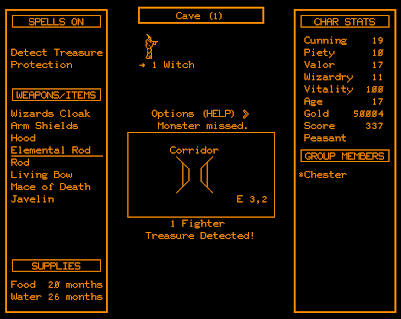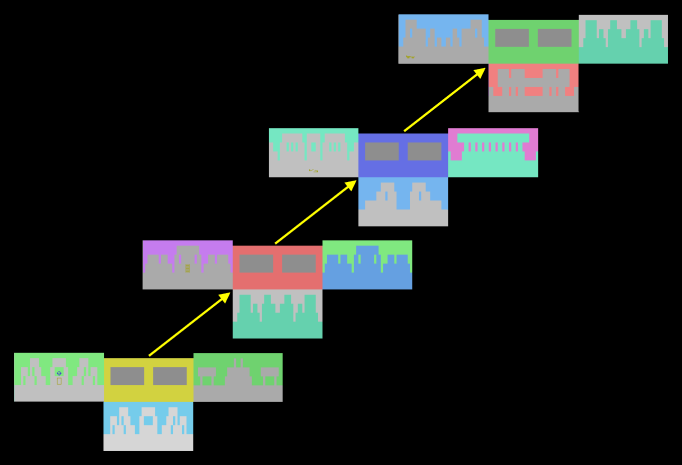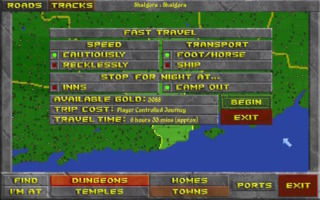This week, let's delve into a quality of life innovation in gaming with a capital Q: Fast Travel. This game mechanic has revolutionized the way we navigate virtual worlds, saving us countless hours of tedious backtracking and uneventful exploration. While it has sometimes been criticized as lazy or for making players miss non-crucial for progression but still worthwhile aspects of the game, various games have implemented it well by turning it into a reward for exploration or overcoming challenges, something with a resource management aspect to it, and/or to only skip the parts of a playthrough that most would considering unnecessary. As gaming technology evolved, so did the concept of fast travel, taking the form of various vehicles or letting the player pick a point on the world map to travel to while in-game time is spent quickly or instantly.

The very first example seems to be from the RPG moria (1975), a move called "Tie a string". This treacherous mechanic works like a teleport beacon, moving the player back to where it was used, however it disappears when moving between floors, and it can even be cut off by monsters if you're unlucky! So while it has some use you can't exactly rely on it. Later games such as Journey to the Centre of the Earth (1984), Exile (Superior Software, 1988) and Flashback (1992) would eventually implement a more reliable teleport beacon as an indestructible item that the player could find.
Some More Retro Game Examples:

Superman (1979) - Here's an early example of a creative, if confusing way to implement shortcuts. If in Superman form and the player moves north or south to the edge of the screen, they end up on another screen, predetermined by the game, which seems to be located to the north or south of the previous screen as if the game was in top down view. When entering a building there's no exit door on the same screen - this is actually a subway system as pictured above. Players can change stops by exiting a screen upwards, or go down, left or right to exit the subway system.

The one-way warp to a later level (Major Havoc (1983), Crystal Castles (1983), "I, Robot" (1984), Super Mario Bros (1985), Bubble Bobble (1986), etc) - This version of fast travel does pretty much what you'd expect, although it tends to be more or less hidden from plain sight as an exploration and/or timing challenge for the player. A key difference is that it can be used as a cheat to completely skip parts of a game as well. Can you beat the aforementioned games without it?
Ultima IV (1985) - This creative RPG is known for its focus on self-improvement according to a set of moral virtues rather than defeating the villain of the story. When it comes to fast travel, the game lets players teleport between moongates, usually located near a town, based on the phases of the world's two moons. The left moon's phase tells you when a certain gate will appear, while the right moon's phase tells you where you'll end up if you go into a gate. This feature actually carried over from the prequel, Ultima III. New to this game however, one can also travel to each moongate via the Gate Travel spell, choosing between them from a list of numbers in the GUI. This feature probably influenced the later Dragon Quest III's use of the Zoom spell.

The Legend of Zelda (1986) - This game introduced action adventure players to the idea of using specific items for fast travel, in this case the recorder/flute which is used to travel between completed dungeons. This works similarly to moongate travel in Ultima III & IV (1983/1985) in that it's not completely straightforward - the destination is determined by which direction Link is facing while using it. It also features magical staircase portals, for warping back and forth between different areas of the overworld. It streamlined the gameplay while treating fast travel as a reward for exploring and overcoming challenges. Surprisingly, Zelda II didn't re-use these features (although there are a couple of shortcuts unlocked in western Hyrule after getting the hammer), but Nintendo revisited and further developed the mechanic in A Link to the Past. Here Link can free a bird using the ocarina, then call on it from anywhere outdoors in the overworld to travel between 8 different locations near instantly. Also new to the series, players can teleport Link to the entrance of a dungeon by using the Magic Mirror.

King's Quest III (1986.) - This creative Point & Click Adventure game is known for making the player start out as a slave to an evil magician, having to work against the clock to get the most out of each day and eventually gain their freedom. Less known is its powerful fast travel system, which might be based on the one in Star Raiders from 1979 - using a magic map found later in the game, which also works like an auto-map by the way, players can freely choose the area of the game world to travel to, so long as they have first moved to that area by foot at least once before. This method became quite popular later on and very similar systems can be found in various famous games such as Ys: Oath in Felghana where it lets you teleport to visited save points, Final Fantasy X, Fallout 3, and Zelda: Breath of the Wild where it lets you teleport to shrines and towers.

Final Fantasy series (1987 and onwards.) - The series that popularized JRPGs in the West is also known for implementing overworlds that allow players to quickly travel between locations, either by using ships (which are not new by this point and are mainly used to travel where you couldn't before), chocobo birds which temporarily protect you from encounters in the overworld (similar in function to horses in Ultima IV), and airships in various forms. This gradually made more and more of their typically large worlds accessible, adding a sense of progression toward sophisticated adventurer status. It also added a sense of freedom to the game which was generally heightened to a great degree in the late-game portion of each one.
Teleporting back to town or back home (Bouken Roman (1986), Dragon Quest (1986), Ys: The Vanished Omen (1987), Legacy of the Wizard/Dragon Slayer IV: Drasle Family (1987), Diablo (1996)) - In the influential Dragon Quest, the Zoom spell allows players to return to the game’s central castle, Tantegel. In the first Ys, the consumable wing item lets players instantly warp back to town, cutting out the backtracking and functioning as an escape for when you're overwhelmed by enemies. The crystals in Legacy of the Wizard, and the W icons in Bouken Roman for the MSX have the same function, and the former also features teleportation via the portrait paintings in its dungeon, provided the player has acquired all four crowns by defeating their guardians. In Diablo, a town portal spell lets the player (as well as other players), teleport back to town and then back into the dungeon before disappearing. In multiplayer, this can be used to quickly join up with someone further into the dungeon without the portal closing, and if two or more players cast the spell, they can keep using another's portal instead of using up their own.

Wing Commander (1990) - This influential and ambitious space combat sim game also offers a unique take on fast travel. Auto-pilot (A key) triggers a short cutscene in which your ship moves towards the next objective (map waypoint). This lets you skip longer distances, without skipping any events since if you encounter enemies or asteroid fields, the gameplay resumes.

Super Mario World (1990) - This game took the series' fast travel to new heights with the introduction of warp pipes and joining together its different areas into one big world. These green pipes allow players to bypass the majority of the game by going into the separate "star road" hub area, providing a shortcut directly to the last area (provided they have the cape or found the red switch palace) as well as between any areas that they had found the exit to the star road from.

The Elder Scrolls II: Daggerfall (1996) - This game offers the most complex and varied fast travel systems thus far. First off, it allows players to instantly teleport between locations they've learned about on the world map at the click of a few buttons, but it also makes them consider a few factors when doing so. In-game time spent when using it, which matters here since most quests are time sensitive. Cautious or reckless travel (affects travel time as well as your HP/MP/Stamina stats when arriving), transport type (on foot, horseback or via ship), and if you want to rest at inns or outside (the former is faster but more expensive). You'll then be teleported to your destination instantly. Many appreciate the convenience this offers, especially in sprawling virtual landscapes, which also tend to be mostly empty and eventless in this game's case (unless you play a later, modded version of it that is). There's also a teleport beacon spell in this game that offers a strategic layer in that it can for example be placed at the entrance to a new dungeon before one goes exploring, or for something shady while in a town. Finally, you can also gain a high rank in the Mages' guild, giving access to one-way teleportation (or two-way if you place a beacon first) to any point marked on your map.
What are your thoughts on warping and fast travel in retro gaming? Do you prefer the simplicity of early implementations like one-way warp gates, for fast travel to be rooted in reality in some way (or perhaps to maintain some challenge during traversal), or do you enjoy the convenience of more modern fast travel systems? Share your favorite examples and thoughts below!
Log in to comment